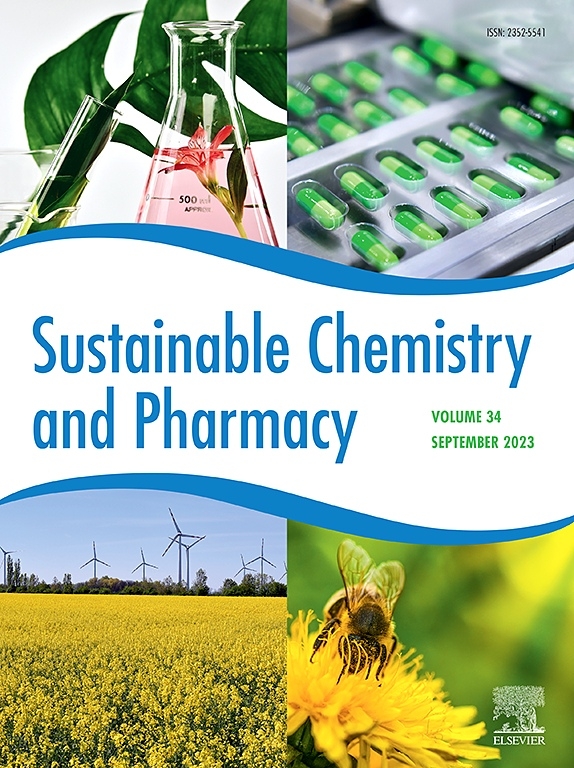含蛋壳粉和粉煤灰的可持续自密实混凝土的性能和微观结构评价
IF 5.8
2区 化学
Q2 CHEMISTRY, MULTIDISCIPLINARY
引用次数: 0
摘要
在追求可持续建筑实践的过程中,本研究评估了蛋壳粉(ESP)和粉煤灰在自密实混凝土(SCC)中部分替代水泥的潜力。ESP含有丰富的碳酸钙,而粉煤灰以其火山灰特性而闻名,它们的替代量分别为5 - 20%和20%。综合实验评估了7天和28天的新鲜特性(坍落度流动、v型漏斗、l型箱形和j型环)、机械强度(抗压、劈裂拉伸和弯曲)以及酸暴露(HCl和h2so3)下的耐久性。通过SEM和EDX进行的微观结构分析证实了最佳剂量混合物的水化和致密性的改善。研究结果表明,用ESP代替10%的水泥,再加上20%的粉煤灰,达到了最佳性能,在28天内,与对照相比,抗压强度提高了14.7%,抗拉和抗折强度增强,耐酸性能也更好。然而,较高的ESP用量(10%)会导致孔隙度增加和未反应CaCO3过多,从而导致强度和耐久性降低。研究表明,ESP和粉煤灰的优化混合物可以生产高性能、生态高效的SCC,为循环经济实践和减少混凝土施工中的碳足迹提供了一条可行的途径。本文章由计算机程序翻译,如有差异,请以英文原文为准。

Performance and microstructural evaluation of sustainable self-compacting concrete incorporating eggshell powder and fly ash as environmentally sustainable cement replacements
In the pursuit of sustainable construction practices, this study evaluates the potential of eggshell powder (ESP) and fly ash as partial replacements for cement in self-compacting concrete (SCC). ESP, rich in calcium carbonate, and fly ash, known for its pozzolanic properties, were used at replacement levels of 5–20 % and 20 %, respectively. Comprehensive experiments assessed the fresh properties (slump flow, V-funnel, L-box, and J-ring), mechanical strength (compressive, split tensile, and flexural) at 7 and 28 days, and durability under acid exposure (HCl and H2SO 3). Microstructural analyses via SEM and EDX confirmed the improved hydration and densification in the optimally dosed mixes. The findings revealed that replacing 10 % of the cement with ESP, along with 20 % fly ash, achieved the best performance, yielding a 14.7 % increase in compressive strength at 28 days compared to the control, enhanced tensile and flexural strengths, and superior acid resistance. However, higher ESP dosages (>10 %) led to strength and durability reduction due to increased porosity and excess unreacted CaCO3. The study demonstrates that optimized blends of ESP and fly ash can produce high-performance, eco-efficient SCC, providing a practical route toward circular economy practices and a reduced carbon footprint in concrete construction.
求助全文
通过发布文献求助,成功后即可免费获取论文全文。
去求助
来源期刊

Sustainable Chemistry and Pharmacy
Environmental Science-Pollution
CiteScore
8.20
自引率
6.70%
发文量
274
审稿时长
37 days
期刊介绍:
Sustainable Chemistry and Pharmacy publishes research that is related to chemistry, pharmacy and sustainability science in a forward oriented manner. It provides a unique forum for the publication of innovative research on the intersection and overlap of chemistry and pharmacy on the one hand and sustainability on the other hand. This includes contributions related to increasing sustainability of chemistry and pharmaceutical science and industries itself as well as their products in relation to the contribution of these to sustainability itself. As an interdisciplinary and transdisciplinary journal it addresses all sustainability related issues along the life cycle of chemical and pharmaceutical products form resource related topics until the end of life of products. This includes not only natural science based approaches and issues but also from humanities, social science and economics as far as they are dealing with sustainability related to chemistry and pharmacy. Sustainable Chemistry and Pharmacy aims at bridging between disciplines as well as developing and developed countries.
 求助内容:
求助内容: 应助结果提醒方式:
应助结果提醒方式:


